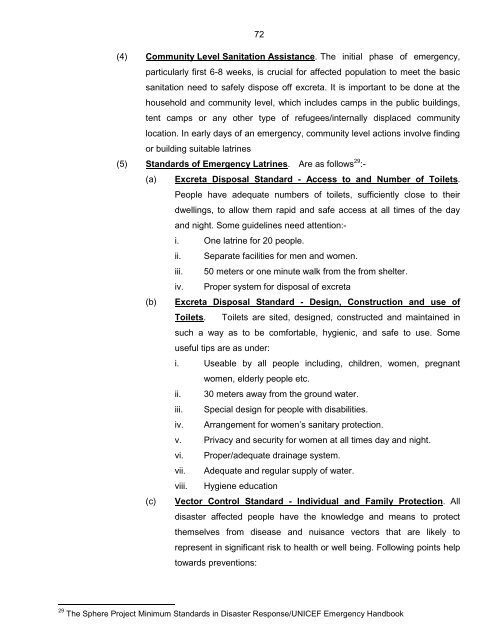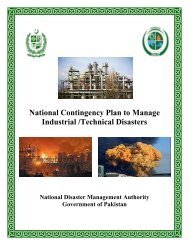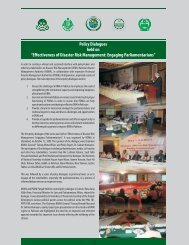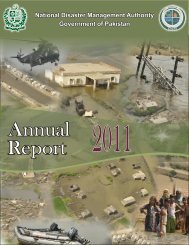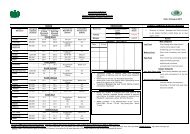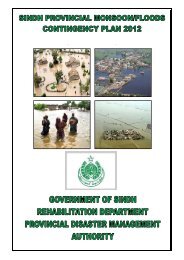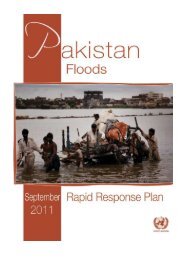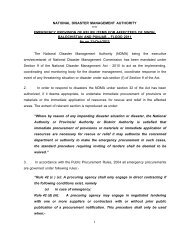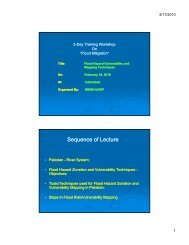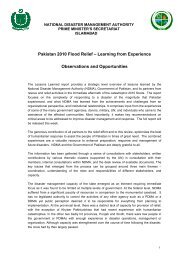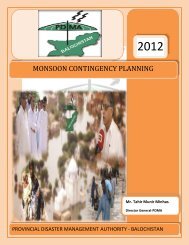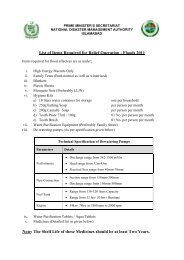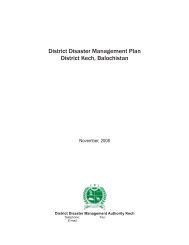National Disaster Response Plan (NDRP) March 2010 - NDMA
National Disaster Response Plan (NDRP) March 2010 - NDMA
National Disaster Response Plan (NDRP) March 2010 - NDMA
Create successful ePaper yourself
Turn your PDF publications into a flip-book with our unique Google optimized e-Paper software.
72<br />
(4) Community Level Sanitation Assistance. The initial phase of emergency,<br />
particularly first 6-8 weeks, is crucial for affected population to meet the basic<br />
sanitation need to safely dispose off excreta. It is important to be done at the<br />
household and community level, which includes camps in the public buildings,<br />
tent camps or any other type of refugees/internally displaced community<br />
location. In early days of an emergency, community level actions involve finding<br />
or building suitable latrines<br />
(5) Standards of Emergency Latrines. Are as follows 29 :-<br />
(a) Excreta Disposal Standard - Access to and Number of Toilets.<br />
People have adequate numbers of toilets, sufficiently close to their<br />
dwellings, to allow them rapid and safe access at all times of the day<br />
and night. Some guidelines need attention:-<br />
i. One latrine for 20 people.<br />
ii. Separate facilities for men and women.<br />
iii. 50 meters or one minute walk from the from shelter.<br />
iv. Proper system for disposal of excreta<br />
(b) Excreta Disposal Standard - Design, Construction and use of<br />
Toilets. Toilets are sited, designed, constructed and maintained in<br />
such a way as to be comfortable, hygienic, and safe to use. Some<br />
useful tips are as under:<br />
i. Useable by all people including, children, women, pregnant<br />
women, elderly people etc.<br />
ii. 30 meters away from the ground water.<br />
iii. Special design for people with disabilities.<br />
iv. Arrangement for women‟s sanitary protection.<br />
v. Privacy and security for women at all times day and night.<br />
vi. Proper/adequate drainage system.<br />
vii. Adequate and regular supply of water.<br />
viii. Hygiene education<br />
(c) Vector Control Standard - Individual and Family Protection. All<br />
disaster affected people have the knowledge and means to protect<br />
themselves from disease and nuisance vectors that are likely to<br />
represent in significant risk to health or well being. Following points help<br />
towards preventions:<br />
29 The Sphere Project Minimum Standards in <strong>Disaster</strong> <strong>Response</strong>/UNICEF Emergency Handbook


